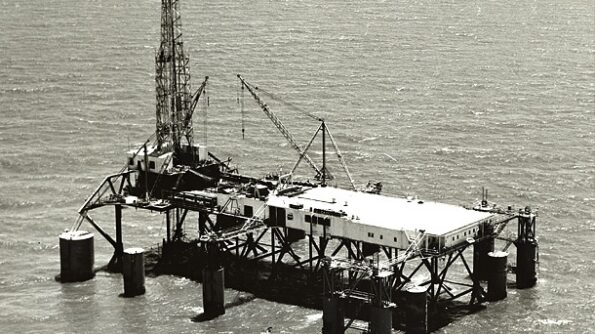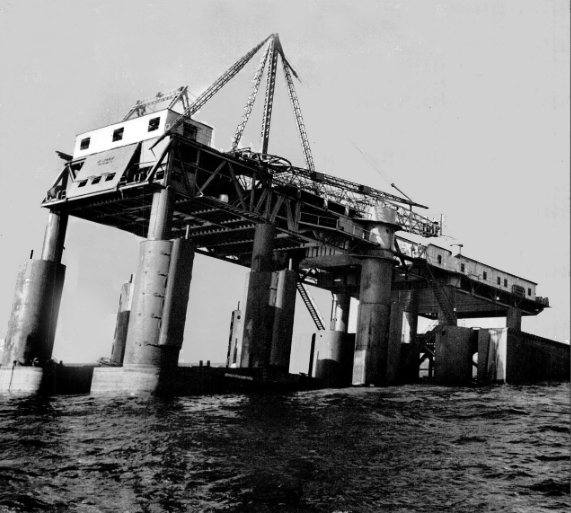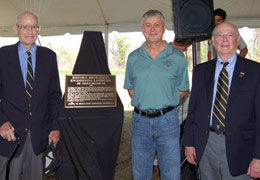The 1954 platform design and technologies declared a mechanical engineering landmark.
Mr. Charlie originated with Navy World War II veteran Alden “Doc” LaBorde, who believed a self-sufficient oil rig could be placed on a barge for deeper offshore drilling. LaBorde’s Mr. Charlie — the world’s first mobile offshore drilling unit (MODU) — has since served as a “glimpse into the past” of the modern energy industry.
In 2012, the American Society of Mechanical Engineers (ASME) recognized the significance of offshore platforms, designating Mr. Charlie an ASME Historic Mechanical Engineering Landmark.

Beginning in 1954 and capable of drilling wells in water up to 40 feet in depth, Mr. Charlie was the first mobile offshore drilling platform. Photos courtesy Murphy Oil Corporation.
When the barge drilling platform Mr. Charlie left its New Orleans shipyard for the Gulf of Mexico on June 15, 1954, it became the world’s first mobile offshore drilling unit (MODU).
Using advanced technology, the self-sufficient Mr. Charlie went to work for Shell Oil Company in a new oilfield in East Bay, near the mouth of the Mississippi River. A reporter from LIFE magazine covered the launch, noting the new “singularly monstrous contraption” could drill “a 12,000-foot hole at a different location every month.”

Mr. Charlie offered an exploration alternative to erecting permanent, pile-supported offshore drilling platforms to be tendered by utility boats. Kerr-McGee had pioneered this approach with the Kermac No. 16 in 1947, but Mr. Charlie could drill in water twice as deep and then move to another site (also see Offshore Oil Piers, Platforms, and Barges).

Mr. Charlie’s column-stabilized design revolutionized the offshore industry. Photo courtesy LIFE magazine, September 14, 1954.
The vessel was the “first offshore drilling rig that was fully transportable, submersible and self-sufficient, allowing it to drill more than 200 oil and gas wells along the Gulf Coast between 1954 and 1986,” declared the American Society of Mechanical Engineers (ASME).
Previous submersible drilling barges were limited to shallow bayous and estuaries where waters did not exceed 15 feet. Learn more about the Kermac No. 16 and other early petroleum industry technologies in Offshore Petroleum Exploration History.
A 2019 book by journalist and professional landman Rebecca Ponton includes interviews with pioneering offshore women of the industry. Breaking the Gas Ceiling: Women in the Offshore Oil and Gas Industry offers personal accounts of finding success in the traditionally male-dominated industry (learn more in Women of the Offshore Petroleum Industry).
Alden “Doc” LaBorde
Using ideas that dated back to a 1928 patent by Louis Giliasso and updated in 1952 by John Hayward, the new design came from a young U.S. Navy World War II veteran and marine engineer who had recently joined the offshore industry. Alden “Doc” LaBorde believed a self-sufficient oil rig could be placed on a barge and floated in deeper offshore waters for drilling wells.
However, LaBorde struggled to find companies in Morgan City, Louisiana, willing to risk investing in his concept. Even the company where he worked as a drilling superintendent, Kerr-McKee, a leading offshore innovator in barge drilling, turned him down.

Laborde’s boss thought the idea “looked good on paper,” but told him, “there are too many unknowns. You have ocean currents, shifting bottoms, hurricanes and many other factors that just would not allow this idea to work as planned.”
The new offshore exploration concept was revolutionary — too much so for all the major companies involved in the oil and natural gas industry, ASME noted in 2012 its History and Heritage Landmarks Program. The society has recognized hundreds of sites and collections of historic importance to mechanical engineering.
“Construction on Mr. Charlie began in 1952 at Alexander Shipyards in New Orleans and was completed in late 1953. Mr. Charlie would go on to drill hundreds of wells — a cumulative 2.3 million feet up and down the Gulf Coast for Shell Oil, as well as many other oil companies,” explained ASME.

The offshore drilling platform design of Alden “Doc” Laborde (left) was recognized as an engineering landmark in 2012 by Morgan City Mayor Tim Matte and Reginald Vachon of the American Society of Mechanical Engineers. Photo courtesy ASME.
Fortunately, LaBorde found support from veteran oilman Charles Murphy Jr., owner of an independent oil company from El Dorado, Arkansas. Murphy backed construction of the revolutionary vessel, which would be named after Charles Murphy, Sr. The first customer would be Shell Oil Company.
LaBorde formed the Ocean Drilling & Exploration Company and contracted with Alexander Shipyard to build Mr. Charlie. A barge 220 feet long, 85 feet wide, and 14 feet deep supported the drilling platform. The platform was 60 feet above the barge.
The drilling vessel was the first mobile offshore unit — and a springboard for many new offshore technologies for drilling deeper wells. Described as an “independent island” and nearly totally self-sufficient with a crew of up to 58, Mr. Charlie drilled hundreds of Gulf of Mexico wells for next 32 years before retiring in 1986.
“By the mid-1980s, offshore drilling activity had moved beyond 40 foot depths, rendering Mr. Charlie ineffective for larger projects.” ASME explained.

“An effort to preserve Mr. Charlie was led by Morgan City oilmen and former workers on the Mr. Charlie. It now serves as an educational museum and training facility,” ASME added.
Mr. Charlie has been preserved on the banks of Louisiana’s Atchafalaya River in Morgan City as the International Petroleum Museum and Exposition.
In May 2004, the National Park System Advisory Board for the U.S. Secretary of the Interior met to consider designating the offshore platform a National Historic Landmark and inclusion in the National Register of Historic Places.
_______________________
Recommended Reading: Offshore Pioneers: Brown & Root and the History of Offshore Oil and Gas (1997); The Offshore Imperative: Shell Oil’s Search for Petroleum in Postwar America

_______________________
The American Oil & Gas Historical Society (AOGHS) preserves U.S. petroleum history. Become an AOGHS annual supporting member and help maintain this energy education website and expand historical research. For more information, contact [email protected]. © 2024 Bruce A. Wells. All rights reserved.
Citation Information – Article Title: “Mr. Charlie, First Mobile Offshore Drilling Rig.” Authors: B.A Wells and K.L. Wells. Website Name: American Oil & Gas Historical Society. URL: https://aoghs.org/offshore-history/mr-charlie-first-mobile-offshore-drilling-rig. Last Updated: June 9, 2024. Original Published Date: June 20, 2018.
The post Mr. Charlie, First Mobile Offshore Drilling Rig appeared first on American Oil & Gas Historical Society.
